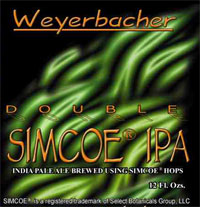Today a tree: the Simcoe hop. Tomorrow the forest: the rest of the hops in the world.
And not just because it seems that how you describe the aroma of Simcoe determines if you drink/smell beer like a man or like a woman.
 Simcoe was only released to the brewing world in 2000 and really is a tree in the forest. Only three Northwest hop yards grew the variety in 2007.
Simcoe was only released to the brewing world in 2000 and really is a tree in the forest. Only three Northwest hop yards grew the variety in 2007.
But it’s become a signature hop for many IPAs and Double IPAs, including Double Simcoe IPA from Weyerbacher in Pennsylvania. As noted yesterday, some West Coast brewers refer to its distinctive presence as “dank.”
In a presentation Friday about “dissecting hop aroma in beer” Tom Nielsen of Sierra Nevada talked about gender and age differences in what people perceive when they smell particular varieties of hops. He mentioned a new hop called Citra (nope, I hadn’t heard of it either) and that men describe it as “tropical fruit” while women find it “catty.”
In the course of the following few hours this came up in conversation with several brewers. But we talked in terms of Simcoe, a hop we all know. Venture too far above threshold (we’re learning this varies widely) and you’ve got a beer that will be described as “catty” in polite company, as “cat pee” after a few pints or, credit Natalie Cilurzo for this, “savignon blanc.”
A little goes a long way, but when used well it brightens a beer that is already supposed to be hoppy.
Whether it is because beer touches my feminine side, because I hate cats or because I’ve tasted so many beers hopped with Simcoe I long ago began greeting new ones with skepticism. And the thought of a “Double Simcoe IPA” (two litter boxes in one beer?) tested my typically optimistic nature.
But, bottom line, a good beer. It sounds like the most back-handed of comments to begin, “It doesn’t smell like cat piss,” but that was a my first thought. I like my Double IPAs a little leaner and with a harder (OK, harsher) hop edge, however I thought whatever I spent for the pint (this was in Manhattan, where I always try to forget what I just paid) was well worth it.
There would be no point in discussing this were the rumors — repeated often during the last few months — true that farmers were about to abandon Simcoe. It turns out to be more susceptible to disease than first thought, and the yield per acre doesn’t justify the risk.
However, while one of three fields where Simcoe was grown in 2007 was ripped out this year (taken over by a cattle farm), three more went in. By 2009 they should be yield a decent crop and the next year will be even better.
Weyerbacher founder Dan Weirback meanwhile has been scrambling. He recently came up with — physically in the brewery, not just promised — 3,000 pounds of Simcoe on top of what he already had. That means he has enough to brew Double Simcoe for nine more months and can expect more will be available by then. “We would have run out (of Simcoe) in late summer,” he said.
Double Simcoe IPA accounts for a modest 10% of Weyerbacher sales. Given the hassles, the fact Weirback passed on only the increased cost of ingredients (in the process lowering his margins) this year, and that overall sales were up 34% last year so he’s got plenty to keep him busy . . . it might not seem like such a big deal were he to let this beer slip into history.
But his customers love it. It speaks to the spirit of his brewery. I’m glad it’s not going away.
That from a man who doesn’t much care for cats.
Interesting. We actually use Simcoe in our IPA, but recently backed off. A little does indeed go a long way, but we’ve found it blends nicely with other hops. And I’m glad Simcoe may be easier to come by in coming years – hopefully by the time we start brewing FOR REAL.
My wife has a very strong reaction to Chinooks above a (fairly low) level, which she describes as “grinding.” I have always assumed this was individual variation. Now I wonder–maybe it’s just my Y chromosome?